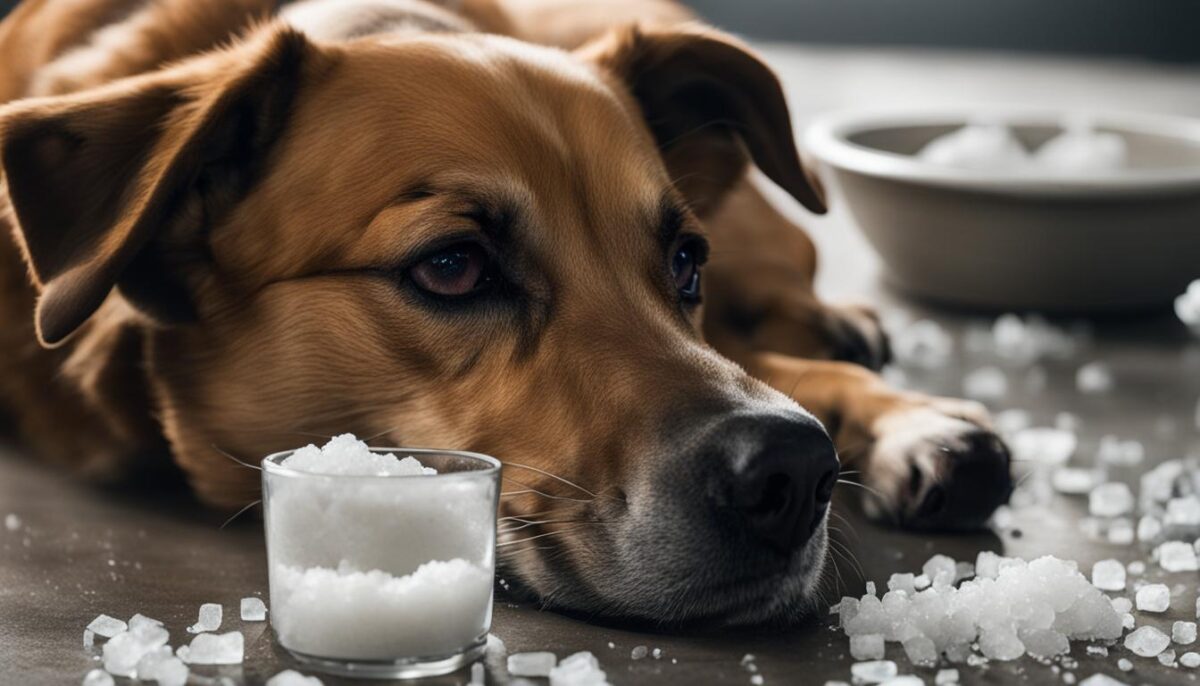Dogs need salt in their diet, but too much can make them sick with hypernatremia. When there is too much sodium in the blood, it can damage cells and affect the brain and nerves. Dogs can eat too much salt from different sources. These sources include salty snacks, table salt, enema solutions, or soy sauce.
Dog owners should know the signs of salt poisoning and protect their pets from it.
Risks of Excessive Salt Intake in Dogs
Excessive salt intake in dogs can pose various risks to their health. If dogs eat salty snacks or human food like table scraps, pizza crusts, chips, or pretzels, they might have problems. One of the most common symptoms of excessive salt intake is excessive thirst. Dogs may drink more water to counteract the drying effects of excessive salt in their bodies. Excessive thirst causes more peeing and dehydration, making fluid balance go off.
Dogs can have high blood pressure if they eat too much salt or have fluid imbalances. High levels of sodium in the blood can make blood vessels narrow and increase blood pressure. Over time, this can strain the heart and increase the risk of heart disease in dogs. Moreover, if you consume too much salt for a long time, it can harm your kidneys and may cause them to stop working. Dogs with kidney problems are more affected by eating too much salt.
To prevent these risks, it is vital for dog owners to be mindful of the amount of salt their pets consume. Avoid feeding dogs salty snacks and human foods known to be high in sodium. Instead, opt for healthy, dog-specific treats that are low in salt. Make sure dogs always have fresh water to stay hydrated and remove excess sodium. To keep their dogs safe, pet owners should control their salt intake and avoid giving them too much.
Table: Common Human Foods High in Salt
| Food | Sodium Content (per 100g) |
|---|---|
| Pretzels | 1500mg |
| Chips | 500mg |
| Pizza | 700mg |
| Bacon | 1500mg |
Note: The sodium content may vary depending on the brand and preparation method. You need to read food labels and be cautious when offering human food to dogs.
Recommended Sodium Intake for Dogs
To keep your dog healthy, it’s important to know how much sodium they should have in their diet. Sodium is a necessary mineral that helps our bodies work, but too much can cause health problems. So, how much sodium should your furry friend consume?
The general guideline is to provide your dog with approximately 0.5% of their daily diet in sodium. For a medium-sized dog, this translates to around 1,250-1,500 mg of sodium per day. It’s important to note that older dogs may need a lower sodium intake of around 0.4% in their daily diet. These values help you give your dog the correct amount of sodium for their nutrition.
Keep in mind that these values aren’t strict limits; they are a suggested range. Dogs generally need less concern for sodium intake compared to humans. People with kidney, liver, or heart disease may need to watch their salt intake.
The Role of Sodium in Your Dog’s Diet
Sodium is a key electrolyte that helps balance fluids in your dog’s body. It also plays a crucial role in supporting muscle and nerve function. Your furry friend needs enough sodium to stay hydrated and healthy.
But, it’s essential to strike a balance and avoid excessive sodium consumption. Having too much salt can cause dehydration, high blood pressure, and harm your kidneys. To keep your dog’s diet healthy, follow the recommended sodium intake guidelines.
| Dog Size | Recommended Sodium Intake (0.5% of Daily Diet) |
|---|---|
| Small | Approximately 500-750 mg |
| Medium | Approximately 1,250-1,500 mg |
| Large | Approximately 2,500-3,000 mg |
To keep your dog healthy and avoid risks from too much salt, watch their sodium intake. To keep them healthy, give them a balanced diet. Don’t feed them salty snacks or human food with lots of sodium. Always have fresh water for them to drink.
Monitoring and Managing Salt Intake in Dogs
To keep your pet healthy, watch how much salt they eat. To keep your dog healthy, give them a good diet and clean water. This will prevent too much sodium and the risks it brings.
Avoid feeding your dog salty snacks and human foods that are known to be high in sodium. These include table scraps, pizza crusts, chips, and pretzels. Instead, opt for dog-friendly treats and snacks that have a lower sodium content.
One option to consider is incorporating bone broth toppers into your dog’s diet. Adding bone broth to meals can be nutritious, but pick low sodium options. To further reduce the salt intake, you can dilute the bone broth with water before serving it to your dog.
Always make sure fresh water is available for your dog to drink. Giving your dog enough water helps remove extra sodium and keeps them hydrated. Remember to replace the water to ensure its freshness.
Benefits of Monitoring and Managing Salt Intake
- Prevents potential health complications associated with excessive salt intake
- Reduces the risk of salt poisoning in dogs
- Promotes a balanced and healthy diet for your pet
- Supports overall well-being and vitality
| Benefits | How to Achieve |
|---|---|
| Prevents potential health complications associated with excessive salt intake | Avoid feeding dogs salty snacks and human foods known to be high in sodium. |
| Reduces the risk of salt poisoning in dogs | Monitor and control the amount of salt your dog consumes. |
| Promotes a balanced and healthy diet for your pet | Choose dog-friendly treats and snacks with lower sodium content. |
| Supports overall well-being and vitality | Provide fresh water at all times and consider incorporating bone broth toppers into your dog’s meals. |
Signs and Treatment of Salt Poisoning in Dogs
If you think your dog has salt poisoning, look for signs and get vet help right away. Early detection and intervention can improve your dog’s chances of recovery.
Dogs with salt poisoning may be very thirsty and urinate. They may vomit, have diarrhea, feel tired, breathe, have seizures, and seem confused. If your dog shows any of these signs, call your vet immediately for help and advice.
When dogs have salt poisoning, they often need fluids to balance their electrolytes. To remove extra sodium from the blood, IV fluids may be given. You may need to watch your dog while they are being treated. This will help make sure they get better and allow for any necessary changes to the treatment.
Your vet might give you medicine to help with symptoms and help you get better faster. They might also give you fluid. These medications can help with salt poisoning symptoms like vomiting, diarrhea, and discomfort. Your vet will create a treatment plan for your dog based on its needs and condition.
| Signs of Salt Poisoning in Dogs | Treatment of Salt Poisoning in Dogs |
|---|---|
|
|
If you think your dog has salt poisoning, get veterinary help right away. It’s important to act to ensure the best possible outcome for your furry friend.
Conclusion
To keep your dog healthy and avoid salt poisoning, it’s important to check their salt intake. Salt is important for dogs because it helps with fluid balance and muscle and nerve function. Excess salt can harm your pet’s cells, brain, and nervous tissue, causing salt toxicity. Make sure to watch the amount of salt in your dog’s diet and don’t give them too much.
To keep your dog healthy, give them a diet without salty snacks or high-sodium human food. Fresh water should always be available to help flush out any excess salt. If you think your dog has eaten too much salt, it’s important to get help from a vet. They can figure out what’s wrong and give the right treatment.
If you watch how much salt your dog eats, you can keep them healthy. It’s up to you to keep your dog healthy, so be aware and take precautions. Take good care of your pet to keep them happy and healthy for a long time.
FAQ
How much salt can dogs have?
Salt is an essential part of a dog’s diet, but excessive salt consumption can lead to salt toxicity. It is important to check and control the amount of salt your dog consumes. To avoid problems from too much salt, make sure there is always fresh water.
What are the risks of excessive salt intake in dogs?
If dogs eat salty snacks or human food, they might get very thirsty and have high blood pressure. They could even have kidney problems. Pet owners must watch how much salt their dogs eat to prevent health problems.
What is the recommended sodium intake for dogs?
The recommended sodium intake for dogs is approximately 0.5% of their daily diet. This equates to around 1,250-1,500 mg of sodium for a typical medium-sized dog. Older dogs may need a lower sodium intake of around 0.4% in their daily diet.
How can I check and manage salt intake in dogs?
To control how much salt dogs eat, give them a healthy diet with less salt. Avoid feeding dogs salty snacks and human foods known to be high in sodium. Make sure dogs always have fresh water to get rid of extra sodium. Some dog owners add bone broth to their pet’s food, but it should be low in sodium.
What are the signs and treatment of salt poisoning in dogs?
If a dog has salt poisoning, it may show signs such as being very thirsty, throwing up, having diarrhea, feeling tired, and being confused. They may also have trouble breathing and experience seizures. If salt poisoning is suspected, immediate veterinary care should be sought. Treatment may involve fluid therapy, including IV fluids, monitoring, and supportive medications.
How important is monitoring salt intake for dogs?
Monitoring salt intake is crucial for maintaining dogs’ health and preventing salt poisoning. Pet owners need to watch the amount of salt in their pets’ food and give them enough water. If you think your pet has eaten too much salt, you should take them to the vet right away. The vet will know the best way to help them get better.

